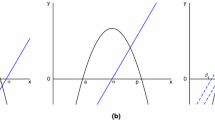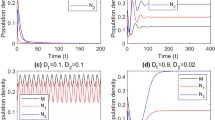Abstract
To understand how patchiness influences population dynamics of a tri-trophic interaction, a tractable model is formulated in terms of differential equations. Motivated by the structure of systems such as plants, phytophagous mites and predatory mites, the model takes dispersal into account at the middle trophic level. The effect of dispersal for the middle level in a tri-trophic system could be either stabilising or destabilising since the middle level acts both as prey and as predator. First a simple model with logistic growth for the lowest level is formulated. A model with logistic growth for the lowest level and instantaneous dispersal has a globally stable three-species equilibrium, if this equilibrium exists. Addition of a middle level dispersal phase of non-negligible duration influences equilibrium stability. In the absence of the top trophic level a limit cycle can occur, caused by the delay that exists in the reaction of the middle level to the changes in the lowest level. With low predator efficiency, it is also possible to have an unstable three-species equilibrium. So addition of a middle level dispersal phase of non-negligible duration can work destabilising. Next the persistence of the third trophic level is studied. Even when the three-species equilibrium exists, the third trophic level need not be persistent. A two-species limit cycle can keep its stability when a three-species equilibrium exists; the system is then bistable. It is argued that such a bistability can offer an alternative explanation for pesticide-induced outbreaks of spider mites and failure of predator introduction.
Similar content being viewed by others
References
Burnett, T., 1979. An acarine predator-prey population infesting roses. Res. Popul. Ecol., 29: 227–234.
Butler, G., Freedman, H.I. and Waltman, P., 1986. Uniformly persistent systems. Proc. Am. Math. Soc., 96: 425–430.
Crowley, P.H., 1978. Effective size and the persistence of ecosystems. Oecologia, 35: 185–195.
Crowley, P.H., 1981. Dispersal and the stability of predator-prey interactions. Am. Nat., 118: 673–701.
Diekmann, O., Metz, J.A.J. and Sabelis, M.W., 1988. Mathematical models of predator/prey/plant interactions in a patchy environment. Exp. Appl. Acarol., 5: 319–342.
Freedman, H.I. and Waltman, P., 1977. Mathematical analysis of some three-species food-chain models. Math. Biosci., 33: 257–267.
Gard, T. and Hallam, T., 1979. Persistence in food webs I: Lotka Volterra food chains. Bull. Math. Biol., 41: 877–891.
Harrison, G.W., 1978. Global stability of food chains. Am. Nat., 114: 455–457.
Hofbauer, J. and Sigmund, K., 1988. The Theory of Evolution and Dynamical Systems: Mathematical Aspects of Evolution. Cambridge University Press, Cambridge, 341 pp.
Levin, S.A., 1976. Population dynamic models in heterogeneous environments. Annu. Rev. Ecol. Syst., 7: 287–310.
Mollison, D., 1991. Dependence of epidemic parameters and population velocity on basic parameters. Math. Biosci., 107: 255–287.
Reddingius, J. and den Boer, P.J., 1970. Simulation experiments illustrating stabilization of animal numbers by spreading of risk. Oecologia, 5: 240–284.
Sabelis, M.W. and Diekmann, O., 1988. Overall population stability despite local extinction: the stabilizing influence of prey dispersal from predator invaded patches. Theor. Popul. Biol., 34: 169–176.
Sabelis, M.W., Diekmann, O. and Jansen, V.A.A., 1991. Metapopulation persistence despite local extinction: predator prey patch models of the Lotka-Volterra type. Biol. J. Linn. Soc., 42: 267–283.
So, J.W.H., 1979. A note on global stability and bifurcation phenomenon of a Lotka-Volterra food chain. J. Theor. Biol., 80: 185–187.
Verboom, J., Lankester, K. and Metz, J.A.J., 1991. Linking local and regional dynamics in stochastic metapopulation models. Biol. J. Linn. Soc., 42: 39–55.
Zeigler, B.P., 1977. Persistence and patchiness of predator-prey systems induced by discrete event population exchange mechanisms. J. Theor. Biol., 67: 687–713.
Author information
Authors and Affiliations
Rights and permissions
About this article
Cite this article
Jansen, V.A.A., Sabelis, M.W. Prey dispersal and predator persistence. Exp Appl Acarol 14, 215–231 (1992). https://doi.org/10.1007/BF01200565
Issue Date:
DOI: https://doi.org/10.1007/BF01200565




